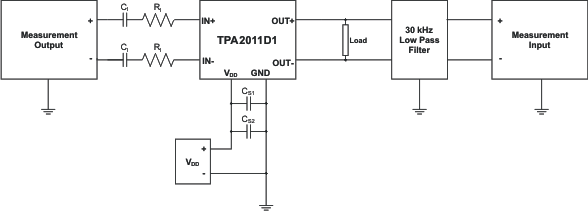SLOS626B December 2009 – November 2015 TPA2011D1
PRODUCTION DATA.
- 1 Features
- 2 Applications
- 3 Description
- 4 Revision History
- 5 Device Comparison Table
- 6 Pin Configuration and Functions
- 7 Specifications
- 8 Parameter Measurement Information
- 9 Detailed Description
- 10Application and Implementation
- 11Power Supply Recommendations
- 12Layout
- 13Device and Documentation Support
- 14Mechanical, Packaging, and Orderable Information
8 Parameter Measurement Information
All parameters are measured according to the conditions described in the Specifications section.

1. Input resistor RI = 150kΩ gives a gain of 6 dB which is used for all the graphs
2. CI was shorted for any common-mode input voltage measurement. All other measurements were taken with CI = 0.1-μF (unless otherwise noted).
3. CS1 = 0.1μF is placed very close to the device. The optional CS2 = 10μF is used for datasheet graphs.
4. The 30-kHz low-pass filter is required even if the analyzer has an internal low-pass filter. An RC low-pass filter (1kΩ, 4700pF) is used on each output for the data sheet graphs.
Figure 28. Test Setup for Typical Application Graphs